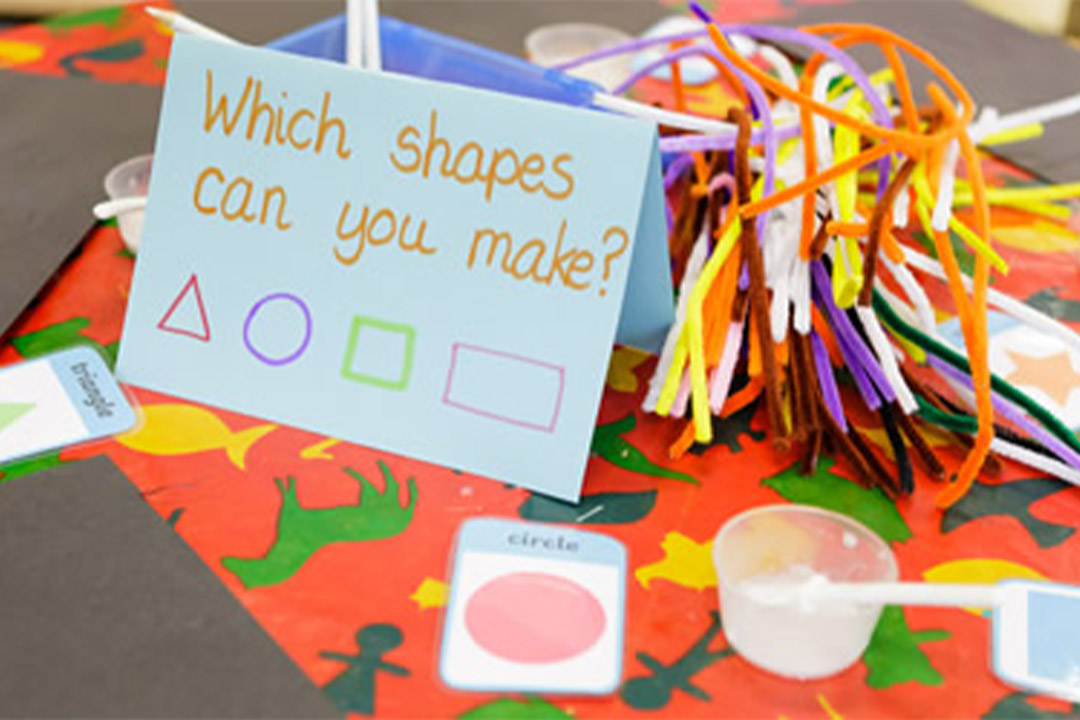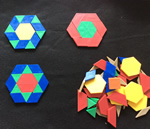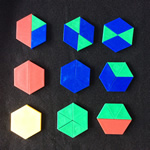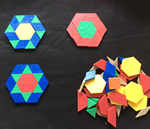Shape and Space
Understanding what happens when shapes move, or combine with other shapes, helps develop wider mathematical thinking

Mathematically, the areas of shape and space are about developing visualising skills and understanding relationships, such as the effects of movement and combining shapes together, rather than just knowing vocabulary. Spatial skills are important for understanding other areas of maths and children need structured experiences to ensure they develop these. Here, the focus is on actively exploring spatial relations and the properties of shapes, in order to develop mathematical thinking (rather than on shape classification, which requires prior knowledge of properties). This section is concerned with developing the two aspects of spatial awareness and shape awareness, with some progression identified within each.
Typical progression of key ideas in this concept
Children need opportunities to move both themselves and objects around, so they see things from different perspectives. This will support them in visualising how things will appear when turned around and imagining how things might fit together.
They need to make constructions, patterns and pictures, and select shapes which will fit when rotated or flipped in insert boards, shape sorters and jigsaws. These experiences will support them in noticing the results of rotating and reflecting images, and in visualising these.
Activities and opportunities:
- riding trikes around interesting routes
- construction activities
- printing and making pictures and patterns with shapes
- posting boxes
- jigsaws
- making a complete circuit with a train track
- directing a simple robot or remote-controlled toy vehicle along a route
- tangrams: 'Can you make a person with the shapes?'
- with toys in a line: 'Can you say what the teddy on the other side is seeing?'
Children need opportunities to be exposed to and to use the language of position and direction:
position: 'in', 'on', 'under'
direction: 'up', 'down', 'across'.
Children also need opportunities to use terms which are relative to the viewpoint:
'in front of', 'behind', 'forwards',' backward's ('left' and 'right' to be used later on as ideas develop).
Create as many opportunities as possible to explore this language, taking advantage of play in the outdoors to explore sequences of body movements (following obstacle courses, directing a friend, etc.).
Activities and opportunities:
- hunting for hidden objects, with some prompts, e.g. 'Look behind the bicycle store, take three steps from the front of the art cupboard…'
- developing and talking about small-world scenarios, e.g. doll's house, miniature village, play park
- acting out their own versions of well-known stories where characters negotiate routes and obstacles, for example, 'We’re Going on a Bear Hunt'
- directing each other as robots.
Small-world play and model building provide lots of opportunities for children to describe things being 'in front of',' behind', 'on top of' etc., and to consider objects from different perspectives. Drawing representations of these relationships is a further challenge. These drawings may include a simple representation of a three-dimensional object from a different viewpoint. For example, 'can you draw your construction from above, looking down on it?'
Activities and opportunities:
- designing a plan for a garden or play area, using a small tray with sand, twigs, building bricks, etc.
- drawing or making a simple map of a route with ‘landmarks’, e.g. houses and trees
- follow a simple map of an excursion.
Through play – particularly in construction – children have lots of opportunities to explore shapes, the attributes of particular shapes, and to select shapes to fulfil a particular need. Support this exploration by discussing items built by children in terms of how towers are built and why certain shapes are chosen to make a tower, and the space that has been created within an enclosure. Ask: 'How did you make that tower?', 'Why were those blocks good ones to use?'
Activities and opportunities:
- construction with structured and unstructured materials
- making dens with varied materials outdoors.
Children need opportunities to construct and create things that represent objects in their environment. As they do this, they should notice shape properties of the object that they want to represent; encourage them to think about the appropriateness of the shapes they choose. Examples of this may include representing a ball as a circle, building a train from wooden rectangular blocks, or using a curved block for the elephant’s trunk.
Activities and opportunities:
- stories as a prompt for creating representations, e.g. building a house for the three bears
- making pictures with found materials as well as structured shapes and blocks.
At this stage, children show increasing intentionality in their selection of shapes, for example using cylinders to represent wheels because they can roll. Draw children’s attention to specific properties by using specific language in everyday situations, while children may use informal language. Properties may include:
- curvedness
- numbers of sides and corners (2D) or edges, faces and vertices (3D)
- equal sides
- parallel sides
- angle size, including right angles
- 2D shapes as faces of 3D shapes.
In play, children show that they are utilising this knowledge by gathering specific items that are needed for their construction, e.g. making a bed for a teddy and gathering blocks of equal length to make the rectangle; taking time with constructing corners so the shapes fit together to make a right angle.
Activities and opportunities:
- making an insect hotel - selecting tube-like shapes from a collection of varied materials, some not fit for purpose
- creating an extended channel for water to flow from a high container to a low one, some distance away
- asking questions, for example: ‘What shapes can you make with three people inside a loop of string? What about with four people?’ ‘What is the same and what is different about these?’
- making shapes with sticks and with their own bodies
- printing with shapes: ‘What footprint do you think this cylinder will make? What about if you roll it?’
As children construct, and appear to be utilising, the properties of shapes, informally ask them about their constructions and representations. Children may use comparisons such as ‘ball-shaped’ or ‘house-shaped’, or start to discriminate between shapes, e.g. a ‘fat’ triangle and a ‘pointy’ triangle, using informal language.
With shapes such as triangles and rectangles, ensure that children are used to seeing a range of examples, and the same shape in different orientations, as well as different sizes, colours and materials.
![]()
Activities and opportunities:
- covering objects in foil and invite children to justify their guesses about what is inside
- making arrangements with a selection of different rectangles, including squares.
As children become more confident with specific shapes, encourage them to spot shapes within shapes. You might talk about small triangles making a bigger triangle or identifying 2D faces of 3D shapes. Pattern blocks are a useful resource, since children can point out the shapes they have used to make their whole pattern:
 |
 |
 |
Also encourage children to predict what will happen when paper is cut or folded, or shapes are combined. Ask: 'What shapes will we see?', 'What will happen if we fold the square in half?', 'What if we put two triangles together?'
Activities and opportunities:
- choosing 2D shapes to construct a 3D model, e.g. using triangles and rectangles to make a tent
- making decorations by folding and cutting
- making 3D shapes using interlocking shapes.
Children think that:
- children thinking that only regular triangles are triangles, only brick-like rectangles are rectangles (i.e. shapes are defined by their image, not by their properties)
- children thinking that squares are only squares when the bottom is horizontal (i.e. shapes are defined by their orientation).
Can a child:
- select and rotate shapes to fit into a given space?
- use positional vocabulary, including relative terms, to describe where things are in small-world play?
- show intentionality in selecting shapes for a purpose, such as cylinders to roll?
- make a range of constructions, including enclosures, and talk about the decisions they have made?
- see shapes in different orientations and recognise that they are still that shape?
- recognise a range of triangles and say how they know what they are?